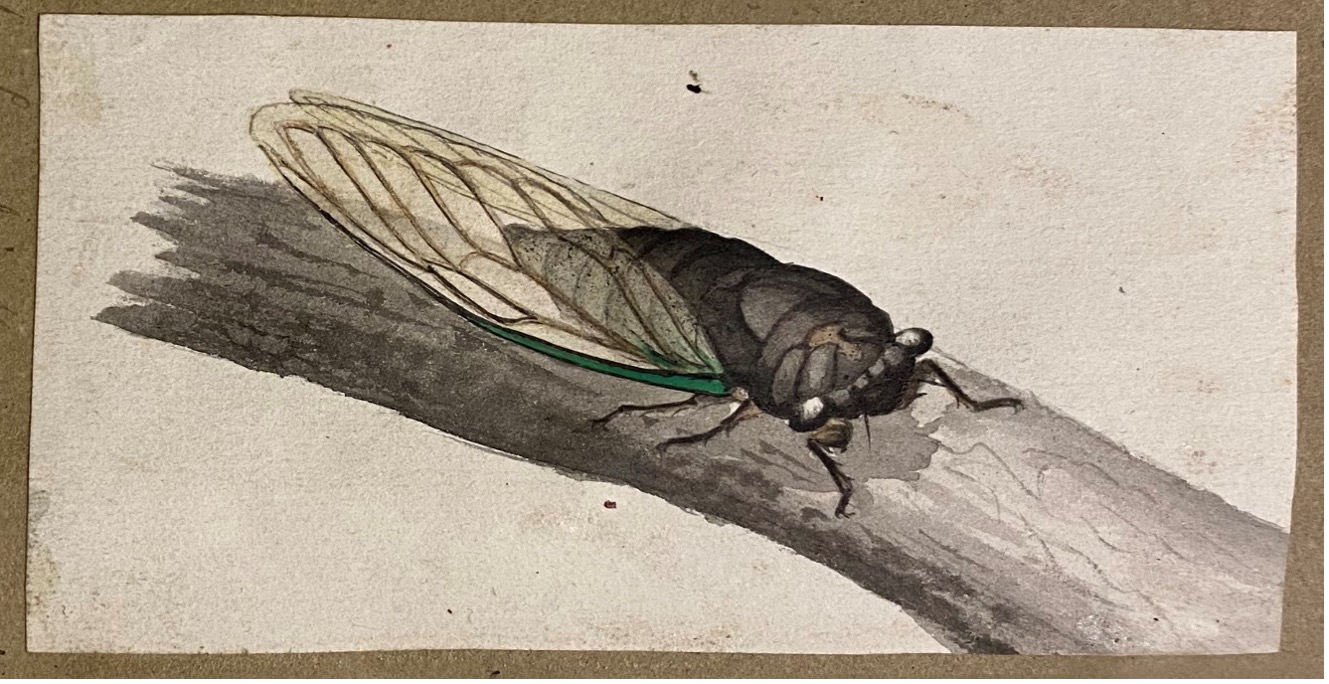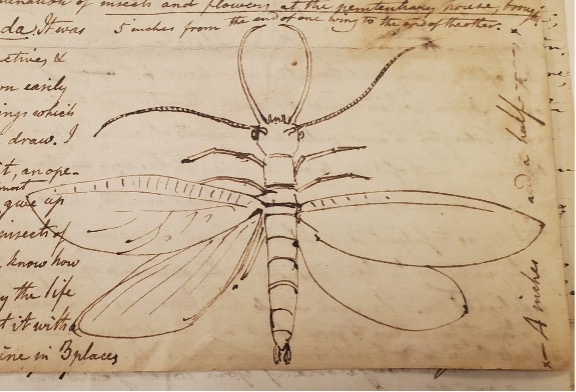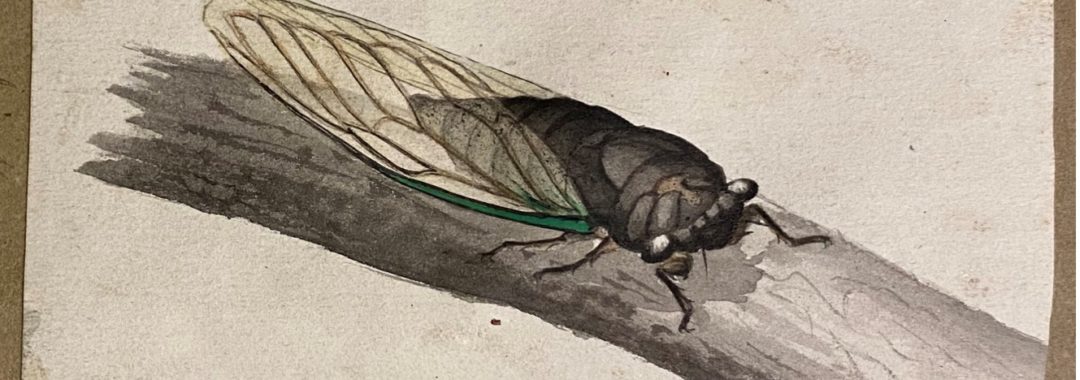
CMC Blog
Cicadas and Locusts in the Manuscript Collection
By: Mickey deVise’, Reference Librarian

Cicada pen and ink sketch, Edward Henry Knight ca 1846; Campbell-Knight Family Papers Mss 895, box 15, vol. 5, pg. 4.3; CMC Manuscripts Collection
The impending Brood X cicada invasion prompted a search of the Cincinnati History Library and Archives for cicada related items. Two images labeled as cicadas were discovered in manuscripts.
The lovely pen and ink sketch above was drawn around 1846 by Edward Henry Knight (1824-1883). His materials form the bulk of seventeen boxes in the Campbell-Knight Family Papers. Knight was a Renaissance man; an agricultural expert, artist, author, inventor, journalist, patent attorney, patent examiner, poet, and U.S. representative to the International Exposition at Paris in 1878. His travel dairies span four decades. Numerous examples of his exceptional artistry and engraving skills of Cincinnati scenes and places where he traveled can be found as well.i
Here is the description which accompanied his sketch: “The locust is the most noisy insect I know, I believe their whistle may be heard a quarter of a mile off, you may often see one or more on some solitary branch of a tree & once in 7 years they come in swarms which proved very destructive to vegetation; we discovered the noises they made to proceed from between two scales of the belly.”ii
Many of his other illustrations and notes concern nature and wildlife as well. As a side note, it is no wonder he was so brilliant. Upon his death in 1883 it was discovered that his brain weighed 64 ounces, the largest known of any American until then, a record that lasted long into the twentieth century, according to Ripley’s Believe It or Not! iii

Insect illustration, unknown artist, 1798; Cist Family Papers Mss C579 RM, box 20, folder 1, item 5; CMC Manuscript Collection
The pen and ink sketch above was sent to Cincinnati resident Lewis Jacob Cist (1818-1885) in a letter written May 23, 1798. The unknown author from Richmond addressed Cist as “My dear Friend” and included comments on politics, geology, education in Virginia, and private manuscripts written at the home of ‘Mr. and Mrs. Washington.’” He spoke of his interest in insects and called this a cicada.iv A recent conversation with Dr. Emily Imhoff revealed the insect in this sketch to be a Dobson’s Fly and not a cicada.v
Here is the author’s description: “An inmate of the penitentiary house, who had observed my inquisitive examination of insects and flowers, brought me a single cicada. It was 5 inches from the end of one wing to the end of the other, amazingly strong and active, it was not able to be kept down easily without breaking its wings which I wished to preserve, & draw. I therefore tried to kill it, an operation which has made me almost give up my enquiries into the insects of this country. But, you know how difficult it is to destroy the life of a butterfly even. I cut it with a pen knife across the spine in 3 places.”vi
The Cist Family Papers provide the record of a prominent 19th century Cincinnati family. Additional material in the collection includes Civil War correspondence and photographs collected by two generations of historian-writers. Lewis Cist’s collection of autographs includes signatures and letters of many famous people including Abraham Lincoln, numerous other presidents, and American and foreign notables.vii
Thanks to CMC Zoology Collections Manager Dr. Emily Imhoff and CMC Library staff Jill Beitz, Christine Engels, Sarah Staples, and Anne Kling for their assistance.
i Campbell-Knight Family Papers Mss 895 Finding aid, pp. 1-2; CMC Manuscript Collection.
ii Ibid, box 15, vol. 5, p. 4.3.
iii Ibid pp. 1-21.
iv Cist Family Papers Mss C579 RM, p. 7; CMC Manuscript Collection
v Conversation with Dr. Emily Imhoff, CMC Zoology Collections Manager, May 16, 2021.
vi Cist Family Papers Mss C579 RM, box 20, folder 1, item 5; CMC Manuscript Collection
vii Cist Family Papers Mss C579 RM, p. 1; CMC Manuscript Collection
Museum Admission
Includes Cincinnati History Museum, Museum of Natural History & Science and The Children’s Museum.
| Adult (13+): | |
| Senior (60+): | |
| Child (3-12): | |
| Member Adult: | FREE |
| Member Child: | FREE |
Members receive discounts!
Become a Member today to save on programs, exhibits and films throughout CMC.
Museum Hours
Open Thursday – Monday
10 a.m. to 5 p.m.
Closed Tuesday and Wednesday
Closed Thanksgiving Day and Christmas Day
Member’s-only early entry: Saturdays at 9 a.m.
Customer Service Hours:
Monday – Sunday, 9 a.m. to 5 p.m.



